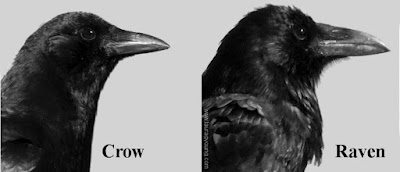 |
My latest: Crow and Raven: A Comparison of Silhouettes.
Watercolor on 16 x 12" illustration board.
I don't know why, but I get a kick out
of identifying things in the natural world. Just as some people can
rattle off the names of their favorite football players or film
actors, I enjoy knowing the names of plant and animal species. If I
come across a tree in a park that I don't recognize, I'll make a
point of noting its leaves, bark, and so on so I can look it up
later.
I think it's because names give me a
starting point to learn more, to understand. I liken it to this: Say
you're are in a room with a bunch of strangers at a skiing lodge in,
oh, say, Norway. As an outsider, these Norwegians might look rather
the same: tall, blond, and athletic. They're just an anonymous,
lutefisk eating
crowd. But once you find out their names, you start paying
closer attention to them. You find differences that make each
individual unique. You learn that Olaf is the only one in the room
with deep brown eyes, or that Ingrid is a strict vegetarian. Once
introduced, you begin on a journey to know them; and, if you are
fortunate enough, you may even become good friends.
So it is with “Crow” and “Raven”.
Or even more particularly, the American Crow (Corvus brachyrhynchos)
and the Common Raven. (Corvus corax). Both hail from the same family
and genus (Corvidae, Corvus) and at a glance can appear nearly
identical.
SIMILARITIES
Shiny black feathers
Black bill with nostrils
partly covered with feathers
Black legs and feet
Dark brown eyes in adults,
grayish-blue for juveniles
Omnivorous – will eat just
about anything
Both are known mimics and
therefore can make similar sounds
Very intelligent, even
recorded using tools
Found in open fields,
forests, and wherever people are found
DIFFERENCES*
American Crows
-- Are somewhat smaller; just a
bit larger than a dove
-- Bill is shorter and slimmer
-- Typical call is a sharper
and higher: “Caw! Caw!”
-- Spread tail in flight is
more fan-shaped**
-- Tends to gather in larger
groups than ravens
-- Will mob a hawk or eagle in
their territory, cawing and swooping at the intruder
-- A bit more restless when
perched, flicking tails more for balance
-- At close range, flapping
wings are silent
-- Rarely if ever soar on
thermals
Bonus fact: the
tongue-in-cheek collective noun to describe a flock of crows is a
“murder”.
Common Ravens
-- Can be considerably larger,
up to the size of a hawk
-- Bill is longer and thicker
-- Adults have a longer ruff or
“hackle” of frontal neck feathers
-- Typical call is softer and
deeper: “Gronk” or “Gaw”
-- Spread tail in flight is
diagnostically more diamond or wedge shaped**
-- Tends towards smaller
groups, frequently found in pairs
-- Will more likely escort a
hawk or eagle out of its territory than mob it.
-- Overall more calm, sedate
behavior when perched
-- At close range, flapping
wings are heard to make a distinct whooshing sound
-- Can be seen soaring on
thermals
Bonus fact: the
tongue-in-cheek collective noun to describe a flock of ravens is a
“conspiracy” or an “unkindness”.
Once you get to know these
two species, you'll notice these differences – and more. But be
careful! Identifying corvids can become habit forming. Especially
when you come to the realization that they contain subspecies, as
well. Four for the American crow, and perhaps up to eleven for the
Common raven.
If you get tired of figuring
THOSE out, well....there's always the study of gulls. ;) ***
*NOTE: These are the
differences just between the American Crow and the Common Raven.
There are additional but lesser-known corvid species in North
America, such as the Fish crow, Northwestern Crow and Chihuahua
raven (Corvus ossifragus, Corvus caurinus
and Corvus
cryptoleucus, respectfully)
that have their own minor differences.
**Aside from voice, I've
found that tail difference is one of the best diagnostics to tell the
two apart. However keep in mind that it can be harder to tell when
the birds are swooping in to land or are already perched. Also,
there are several non-American species of raven and crow that this
does NOT work for, such as the fan-tailed raven Corvus rhipidurus
of Africa or the little raven Corvus mellori of
Australia, which have
fan-shaped tails instead of wedge-shaped ones.
*** In some birding circles,
becoming involved with the minutia of gull identification has been
said to cause mild bouts of insanity.
*********
Laura's Links
Facebook: https://www.facebook.com/Laura-G-Young
Twitter: https://twitter.com/LauraGYoung
Instagram: https://www.instagram.com/laura_g_young
YouTube: https://www.youtube.com/user/LauraGYoung


No comments:
Post a Comment